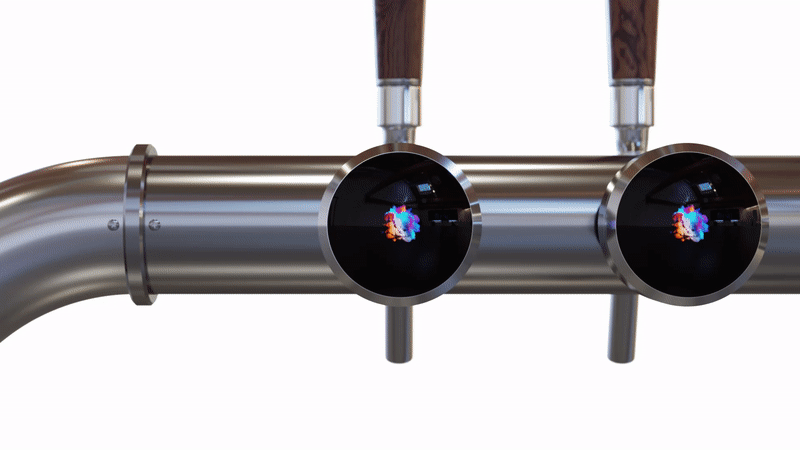Visual communication continues to evolve. While traditional signage remains a cornerstone of brand visibility, digital signage is opening new possibilities for brands looking to enhance their customer communication.
The key lies not in choosing between digital and traditional signage, but in understanding how to leverage each format's unique strengths. In this blog we will mainly highlight the beer and beverage market and retail industry but this of course applies to many more industries. Explore the advantages of incorporating digital signage into brand marketing strategies.
Understanding the Strategic Value of Digital Signage
Imagine walking into your favorite retail store during different times of the day. In the morning, digital displays welcome early shoppers with breakfast promotions, seamlessly transitioning to lunch specials as the day progresses. Meanwhile, the store's traditional exterior signage maintains consistent brand presence. This dynamic interplay between traditional and digital signage illustrates why the most successful visual communication strategies often embrace both.
According to a 2023 study by Grand View Research, this isn't just anecdotal - the global digital signage market is expected to grow at a compound annual growth rate of 7.7% from 2023 to 2030, driven by increasing demand for enhanced customer engagement solutions.
Investment Considerations
While digital signage represents a significant initial investment compared to traditional solutions, understanding the full scope of costs helps in making informed decisions. Beyond hardware and installation, consider the ongoing needs of content management systems, maintenance, energy consumption, and content creation resources. Think of it as building a dynamic communication ecosystem rather than simply installing displays.
When Digital Makes Strategic Sense
Picture a busy shopping center during peak hours. Digital displays adapt in real-time to foot traffic patterns, showcasing different content to morning commuters versus afternoon shoppers. This adaptability explains why a 2023 Nielsen study found that 80% of venues with digital signage experienced up to a 33% increase in customer engagement.
For businesses with multiple locations, digital signage offers a powerful advantage: centralized control with localized customization. A beverage brand, for instance, can maintain consistent branding while adapting promotions to local preferences and events. This flexibility extends to pricing as well - particularly valuable in industries where prices fluctuate regularly.
Making It Work: Technical Considerations
The success of digital signage heavily depends on thoughtful implementation. Before installation, consider the environment where your displays will live. Light conditions, viewing angles, and traffic patterns all play crucial roles in effectiveness. Just as you wouldn't place a traditional sign where it can't be seen, digital displays require careful positioning for maximum impact.
For content strategy, successful implementations follow what we call the 10-5-3 rule: grab attention within 10 seconds, convey your key message within 5 seconds, and present your call to action within 3 seconds. This simple framework ensures your content maintains impact in high-traffic environments.
Integration and Growth
The most successful digital signage rollouts often start small and scale strategically. Key factors to consider include:
- Test effectiveness in high-impact areas
Before rolling out a full-scale digital signage network, start with strategic locations where your message will reach the most relevant audiences. For beverage brands, this might mean installing your first digital display above a busy bar area or near the entrance of a high-traffic retail store. These initial installations serve as your learning laboratory, allowing you to understand real-world performance without committing to a full-scale deployment.
- Refine content strategy based on results
Once your pilot displays are running, pay close attention to how different types of content perform. Which messages resonate most with your audience? Perhaps you'll discover that animated content draws more attention than static images, or that product promotions perform better at specific times of day. Use these insights to fine-tune your approach. For instance, a beverage brand might learn that showing cold, refreshing imagery during peak afternoon hours drives more immediate sales than standard brand messaging.
- Train staff on system management
Digital signage is only as effective as the team managing it. Your staff needs to understand not just the technical aspects of the system, but also its strategic role in your communication mix. - Measure impact through concrete metrics
Success in digital signage must be quantifiable. Establish clear metrics aligned with your business objectives, such as:
- Comparing sales data before and after installation
- Tracking customer dwell time near displays
- Monitoring engagement with interactive content
- Measuring promotional redemption rates
- Analyzing foot traffic patterns around displays
These metrics provide concrete evidence of your digital signage's effectiveness and help justify further investment.
- Scale based on proven success
Once you've proven success in your pilot locations, use those learnings to inform your expansion strategy. The key is to grow methodically, ensuring each new installation benefits from the lessons learned in previous deployments.
This systematic approach to digital signage implementation helps minimize risks while maximizing the potential for success. Rather than rushing into a full-scale deployment, taking these measured steps allows you to build a strong foundation for your digital signage strategy, ultimately leading to better results and stronger ROI.
Remember, the goal isn't just to install digital displays – it's to create an effective communication channel that enhances customer experience and drives business results. By following this structured approach, you're much more likely to achieve those objectives.

Looking to the Future
The digital signage landscape continues to evolve with exciting possibilities on the horizon. Interactive displays are becoming more sophisticated, while AI-driven content optimization promises to make messaging even more relevant. Integration with mobile devices, enhanced analytics capabilities, and sustainable energy solutions are all shaping the future of this dynamic field.
Making Your Decision
When considering digital signage, think about your specific needs and environment. How often will your message need updating? What are your audience's viewing patterns? How will digital displays complement your existing communication channels? The answers to these questions will guide you toward the right solution for your unique situation.
The future of visual communication isn't about choosing between traditional and digital signage - it's about understanding how to leverage both for maximum impact. By carefully considering your needs, environment, and objectives, you can create a signage strategy that engages your audience and drives results.
*Grand View Research, Digital Signage Market Analysis Report, 2023
**Nielsen Digital Signage ROI Study, 2023





